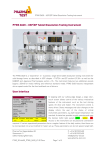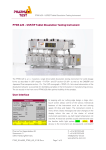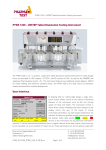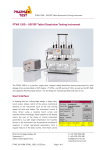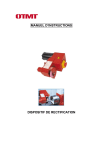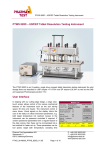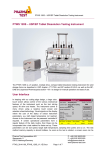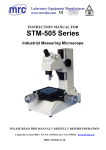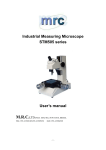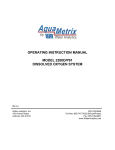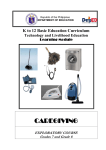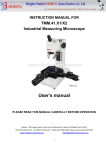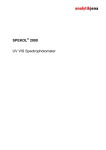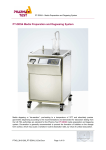Download PTWS 310 – USP/EP Tablet Dissolution Testing
Transcript
PTWS 310 – USP/EP Tablet Dissolution Testing Instrument PTWS 310 – USP/EP Tablet Dissolution Testing Instrument PTWS 310, compact, complete, all-in-one design affords easy and safe handling for correct tool height and sampling positions – synchronous stirrer start - unique instrument design and handling security vibration absorbing design - includes testing method filing system. The ideal instrument for all USP <711/724> and EP <2.9.3/4> applications, for which automated and manual operation is required. Tablet dissolution testing is one of the most important tests during development and manufacturing of solid dosage forms, transdermals, ointments and creams, suppositories etc. Nearly all international pharmacopoeias describe a dissolution test instrument, in which at least 6 samples should be tested. The test vessel design, stirring speed range, temperature range and accuracy, stirrer design and relevant tolerances are clearly specified. Today the instrument operator of such an instrument expects not only conformity with the pharmacopoeia description, but also easy operation and accessibility to the test vessels. This means a dissolution bath should offer both good manual access as well as automation facilities. The PTWS 310 offers both. Pharma Test Apparatebau AG Siemensstr. 5 63512 Hainburg/Germany PTAG_30-20310_PTWS_310_V2.0E P: +49 6182 9532 600 F: +49 6182 9532 650 [email protected] www.pharma-test.com Page 1 of 12 PTWS 310 – USP/EP Tablet Dissolution Testing Instrument All test vessels are placed in 4+4 rows and it is easy to remove spent samples and refill with solvent. The clear-view U-shaped Plexiglas water bath and the central drainage tap make sure that the bath can be cleaned any time should this be required. The solid design of the bath and the same clearance of the bath frame to any of the vessels inside it, ensures a perfect temperature distribution throughout. A built-in water diffuser distributes the heated media inside the bath. The bath itself rests on vibration absorbers. This avoids any vibration transfer from either inside the instrument or even from external equipment placed on the same bench surface. Test using USP Prednisone RS Tablets have clearly shown that vibrations which exceed 0.00254mm displacement have a tremendous influence to the release rate. The PTWS 310 can be equipped with an EPE auto sampling manifold system. The PTWS 310 is equipped with the synchronous TM manual tablet drop magazine which inserts all samples at the same time whenever the test conditions are within the valid operational range (temperature/speed) An automated motor driven tablet drop magazine is available as an option. If the EPE sampling system option is attached the PTWS 310 can be equipped with the ITM external temperature probes to record both, bath and individual vessel temperature as well as a pH-probe to measure pH values before and after a test. The Monoshaft™ design means you only have to change the stirrer inserts. The shafts are simply placed into the drive system, calibrated once and then remain there with no need for further adjustment. Regardless of tool choice, the head can be moved up so as to allow easy removal of the test vessels from the bath. This illustration shows the shafts equipped with stainless steel paddle blades. A total of 8 immersion positions operate within the PTWS 310 system. They are mainly for the “Paddleover-Disk” method, a cleaning position and to adjust the drive head automatically. PTAG_30-20310_PTWS_310_V2.0E Page 2 of 12 PTWS 310 – USP/EP Tablet Dissolution Testing Instrument Another unique labor-saving design feature is the easy access pump and heating system as well as the power connection. Both are located at either side of the instrument. This means that there is no need to move the bath from its position should the instrument need to be qualified or maintained. Within the pump housing unit, the built-in circulation pump is spring loaded for totally vibration-free operation. The measurable vibration is even lower than those systems which use a separate heating system placed to the same bench. Incorrect settings of the bath are monitored, a warning is displayed if the temperature or speed is outside the target settings or even the water level is too low. The traffic light information center clearly shows the operator the status of the instrument, running well = green light - slight problem = yellow or out of specification = red. All this is automatically logged; the log file can be printed any time using the built-in thermo printer. The Pharma Test PTWS 310 tablet dissolution tester exceeds all technical requirements which are required by USP <711/724>, FDA, European <2.9.3/4>, Japanese and German Pharmacopoeias. Testing Method Filing Additionally, the instrument can file testing methods which include information about stirring speed, sampling timing, duration time of EPE sampling probe inside the media etc. The number of testing methods filed on an USP memory stick is nearly unlimited. The user access administration of the filing system protects the system from unauthorized actions. Using the built-in printer a print out of a short OQ as well as an instrument log report and settings is possible at the end of a run. This is a useful way to print and store hard copy run time logs of dissolution runs in compliance with current GMP practice. PTAG_30-20310_PTWS_310_V2.0E Page 3 of 12 PTWS 310 – USP/EP Tablet Dissolution Testing Instrument How Does the PTWS 310 Operate? Simply press a key to move the instrument’s drive housing upwards - free access to all vessels for filling or cleaning. The automated self-adjustment system of the vessels inside the water bath cover ensures correct positioning of the vessels with respect to the stirrer axis. All stirrers start simultaneously. The big LCD screen will inform if any fault has been detected, like low water level temperature outside the tolerance - insufficient pump flow etc., while the information automatically is filed in the instrument’s log. To dive the upper head down the 2 safety switches need to be pressed which requires two hand operation for additional safety. Red - yellow - and green "traffic" lights inform the user from anywhere in the laboratory of the instrument’s status. Yellow will light up if any specification is slightly outside the limits but with no major problem for the correct performance of the dissolution run. The red light comes on as soon as any critical fault has been found which would surely question the validity results of test results, such as incorrect stirrer position etc. For automated sampling the EPE electrical sampling probe manifold may be used. It can be added at any time to the instrument. 8 stainless steel sampling probes, each with its own filter, are moved into the media for the sampling time duration and removed after. They may also stay inside the vessels during the entire test, if the user prefers to do so. A computer controlled dissolution system will be able to control all instrument parameters and record the instrument output data. The Pharma Test tablet dissolution instruments can be used in compliance to apparatus 1, 2, 5 and 6 of the USP <711/724>and European Pharmacopoeia <2.9.3/4>. Testing Method Storage Management The PTWS 310 tablet dissolution testing instrument offers a unique testing method data management system which uses an USB memory stick to file the programmed testing description (method). A method includes information of stirring speed, bath temperature, sampling sequences, sample probe immersion time, tool type, total testing time, user name, date, time, etc. All this information can be entered using the keyboard of the PTWS instrument or an external PC. The data are filed with an USB stick and so can be transferred to another PTWS dissolution bath easily. If transferred the methods have to be registered for the serial number of the new bath first before they can be used. This feature includes in addition access control for users. Different access rights can be allowed to a user group, such as method development, instrument qualification and calibration, etc. A quick-start optionally allows using the PTWS dissolution bath without the need of logging on the instrument with a password. PTAG_30-20310_PTWS_310_V2.0E Page 4 of 12 PTWS 310 – USP/EP Tablet Dissolution Testing Instrument Automation Capabilities of the PTWS 310 Using a UV/VIS spectrophotometer with multiple-cell-changer and interfacing via the WinDiss ARGUS dissolution software program. WinDiss ARGUS offers drivers for most commonly available UV/VIS spectrometer types, like the Agilent 8453 diode array, or conventional UV/VIS monochromatic spectrophotometers, preferable double beam and scanning versions, like the T70, Cecil CE, Perkin Elmer Lambda etc. A RS232 driver software to control the instrument using Agilent Chemstation™ software (dissolution package) is available as well. Automated Sampling Systems Sample fractions automatically, using the DSR-M X-Y-Z dissolution sampling robot which can be connected directly to the PTWS 310. Also the PTFC-2 fraction collector can be connected and controlled directly by the PTWS 310 dissolution bath. For the media transfer either a peristaltic or piston pumps are used. Both DSR-M and PTFC-2 are fully controlled by the PTWS 310 instrument no additional software is required! PTAG_30-20310_PTWS_310_V2.0E Page 5 of 12 PTWS 310 – USP/EP Tablet Dissolution Testing Instrument Automation Incorporating the PTWS 310 Closed Loop Online Systems This popular configuration is elaborate, but allows real time calculation of results using the WinDiss ARGUS dissolution software and is by definition PC controlled. With a diode array spectrophotometer, an 8-cell-changer for either a 10x10 or a 20x10mm path length cuvettes, and pump, the basic automation elements are entered into the program structure. This data, once installed will cause the software to further interrogate the user as to the configuration of the automation elements (wizard technology). Taking the spectrophotometer as an example, the program needs information as to whether there is a cuvette changer or not and if so, then is it a 6-, 8-way or 16way. This is vital information as the blank medium has to be compared to the reference cell, and zeroed at the appropriate wavelength. In the case of the 6-cell changer this is done on cell 1 at the start of the measurement cycle only, whereas with an 8-way changer, the blank medium is normally selected to be transferred to cell 7, with the standard (for concentration calculation) in cell 8. This means that the medium can be compared to the reference cell and zeroed at the start of each measurement sequence. After the zero has been established the measurement sequence is then cell 8, followed by cells 1 to 6. There are many spectrophotometer and auto sampler drivers available for connection to Pharma Test dissolution systems, even on-line HPLC. Keeping Cost Sensible… We, at Pharma Test have opted to take the work out spectrometer selection and accessory hunting by offering complete systems which have not only differing degrees of sophistication but which also offer affordable options to cover all budgets. PTAG_30-20310_PTWS_310_V2.0E Page 6 of 12 PTWS 310 – USP/EP Tablet Dissolution Testing Instrument Suitable Pumps CAT Piston Pump Peristaltic Pump Suitable Spectrophotometers with Cell Changers T70 split beam spectrophotometer and 8-cell changer, Cecil CE 3200 with 8-cell-changer, Perkin Elmer Lambda, Shimadzu, Carry 50, Analytic Jena Specord, etc… UV/VIS diode array types, like Agilent 8453 with 6- or 8-cell-changer Principe of Operation The operator describes the operational procedure within the wizard driven software. Then the system will flag when the samples have to be introduced; after this point, the dissolution system works automatically. Prior to the measuring time the pump will be started and circulate the solvent through a 5 or 10 micron filter. During a measurement the pump is stopped temporarily and data is read and stored by the PC. The same is repeated for any programmed measuring cycle. As well as the measured absorbance, speed, temperature and pH-values (optional) are recorded. The selectable option to run a reference standard solvent, (which is measured in each cycle) or the entry of a theoretical maximum absorbance is available. Running a standard offers some advantages as results that may be influenced by a less than optimum light source, evaporation or temperature influences are corrected by the reference measurement. At the end of a run the operator creates his report and chooses which data that he needs to have printed. As all results remain filed within the system, a batch comparison statistical analysis can be performed at any time. For further information about dissolution automation ask for our WinDiss ARGUS dissolution software flyer or for demo version. PTAG_30-20310_PTWS_310_V2.0E Page 7 of 12 PTWS 310 – USP/EP Tablet Dissolution Testing Instrument The PTWS 310-2 Instrument Variant for 2 Liter Dissolution Vessels The PTWS 310-2 2 liter version includes 8 glass vessels and 8 Monoshaft™ 2 liter stainless steel paddles. Basket adapters are available as well. The PTWS 310-2 instrument can be equipped with 1 liter USP/EP vessels as well, while the stirring tools remain the same as for the 2 liter operation. Unlike the standard 1 liter version, the stirrers can be started either synchronous or sequentially (staggered start option). PTAG_30-20310_PTWS_310_V2.0E Page 8 of 12 PTWS 310 – USP/EP Tablet Dissolution Testing Instrument Advantages Some of the highlights the PTWS 310 offers are: Instrument suitability test prior to any test start or during a run: SST test Auto-control to ensure correct water level, tool speed and bath temperature User access control and access level administration Testing method filing system (almost unlimited space on USB flash drive) Safety system for the electric lift drive, 2-hand button operation to move the drive head automatically downwards Vertical and horizontal adjustment facilities of water bath, vessels, and stirrer drive No position change of drive head when changing stirring tools due to Monoshaft™ design 8 selectable drive head immersion positions to suit different stirring tools, like position 1 for USP/EP Apparatus 1 and 2, position 2 for Paddle over Disc (disc diameter 40mm), position 3 for Paddle of Disc (disc diameter 60mm), etc. Water bath placed on vibration absorbers and spring loaded assembly of pump to ensure vibration free dissolution testing U-shaped water bath design for long life security including central drainage tap Clear LCD screen (10x10cm) to display actual operational status; traffic light information to highlight any errors Menu driven stirrer speed entry for the stirrer drive, display of actual speed of the stirrer drive motor Visible and acoustic alert informs the user of any action which should be taken with the instrument Fully-automated self-check and re-adjustment of stirrer drive and bath thermostat as soon as any change has been detected Programmable heater start and stop time: saves energy Electronically controlled central drive system lifting device Easy access to all 8 test vessels Manual tablet magazine and incorporated low evaporation vessel cover as standard supply Very short pre-heating time and narrow temperature accuracy limits of temperature control due to new stainless steel vibration free water bath diffuser jet Heater safety system includes thermo-switch, thermo-fuse and flow-sensor Additional stirred vessels to take either reference standard or blank media Built-in instrument log; files all changes and calibration data during duty cycle time of the instrument: prints content onto the built-in printer Calibration menu for stirrer speed, bath temperature, pH-probe RS-232 interface for full externally controlled operation and instrument data transfer Manual temperature sensor probe to read temperature of each vessel prior to and after a run; during operation the probe is placed into the reference vessel for continuous monitoring OQ/PQ auto information, performance sequence programmable Instrument housing made out of stainless steel, always clean, GLP conforming Individual vessel centering IQ/OQ documents included free of charge PTAG_30-20310_PTWS_310_V2.0E Page 9 of 12 PTWS 310 – USP/EP Tablet Dissolution Testing Instrument Features The main features of the PTWS 310 are: Fully USP <711/724> and EP <2.9.3/4> compliant 8 stirred positons Centrally located electronic lift drive to raise and lower the head Method management and user administration Optical and acoustic signals to inform about sampling intervals Optical information on shows the instrument status by different colors (green = ready to use, yellow = preparing to use, red = error encountered) Interfaces – RS232 to connect PT-DL1 data logger; I/O port for remote control in offline automated applications Standard Scope of Supply The PTWS 310 comes ready to use with the following standard scope of supply: One set of stainless steel paddles One set of 1000ml Borosilicate glass vessels One set of depth adjustment balls One bottle of ALGEX water preservative Comprehensive documentation folder including: User manual IQ documentation OQ documentation Instrument logbook Compliance Certificates for vessels and stirring tools Options In addition to the standard scope of supply Pharma Test offers a broad range of accessories and options including: EPE auto sampling manifold system Direct control of peripheral instruments via I/O port such as PTFC-2 fraction collector TMA automated synchronous tablet drop magazine (manual TM tablet magazine included in standard supply) ITM individual temperature measurement device can be attached to the EPE auto sampling system: monitors temperature of medium in each vessel pH-probe to read pH value of each vessel prior to and after a test run External Buzzer connected to the I/O port PTWS 310-2 2 liter vessel version (can also be used with 1 liter vessels) PTSW-0 dialysis cell for suppository dissolution testing Amber colored vessels for UV sensitive test materials Mini vessel set including mini paddles Full range of Monoshaft™ stirring tools available Full range of certified validation tools available PTAG_30-20310_PTWS_310_V2.0E Page 10 of 12 PTWS 310 – USP/EP Tablet Dissolution Testing Instrument Example Print-Outs Print-out while start up - logging sequence is 2 minutes Printed and filled OQ forms PTAG_30-20310_PTWS_310_V2.0E Page 11 of 12 PTWS 310 – USP/EP Tablet Dissolution Testing Instrument Technical Data (Standard 1 Liter Version) Parameter Specification Display LCD digital graphical display (10 x 10cm illuminated) for RPM, temperature, time, timer and pH (optional) functions Keyboard Functional and alpha-numerical keys Number of Stirred Vessels 8 (4 + 4 configuration) Additional Stirred Vessels Used to store media for refilling or reference standard Acoustic Signal Programmable acoustic signal for operator information Interface 1 RS-232 port, 1 TTL relay port to connect a PTFC-2 fraction collector and a pump, 1 pH-probe port Printer Built-in thermo printer, prints test log as well as OQ information Speed Control Adjustable from 20 rpm to 250 rpm, ± 2% of set speed typically < 1% accuracy Temperature Control 750 W heater and pump system, protected against overheating and "no water" operation”, adjustable from about 25°C - 50°C, water diffuser for even water distribution all over the bath Temperature Accuracy ± 0.2°C inside the water bath Water Circulation Water circulated through special diffusion system pH Measurement (optional) 0.05 - 9.00, ± 0.02 pH units accuracy Heat-Up Energy saving, programmable, "auto start" heater function Calibration Built-in calibration procedures for speed, temperature control and pHprobe, OQ/PQ sequence programmable including alarm indicator Stirrer Wobble Better than 0.2mm total run out Stirrer Tools Monoshaft™ stirrer design, USP Apparatus 1, 2, 5, 6 tool adapter, cream cell, transdermal patch tools - every tool individually coded Vibration Prevention Bath and pump system on vibration-free mounts Vibration Level Less than 0.00254mm displacement inside vessels Vessel Centering Auto centering inside the bath cover, easily aligned bath using centering tools and stainless steel support dish Test Vessels 1 liter USP glass vessels supplied with individual number coding (2 liter vessel instrument version available) Evaporation TM tablet drop magazine covers all vessels and includes suitable tool/sampling tube cut outs included in the standard supply scope Packaging Weight Net: 75kg, Gross: 110kg - Dimmen. : 90cm x 65cm x 75cm Certification All components certified to USP / EP requirements CE / EMC Certification All CE / EMC Certification provided Validation All IQ & OQ documents included We reserve the right to make technical changes without any prior notice. PTAG_30-20310_PTWS_310_V2.0E Page 12 of 12














